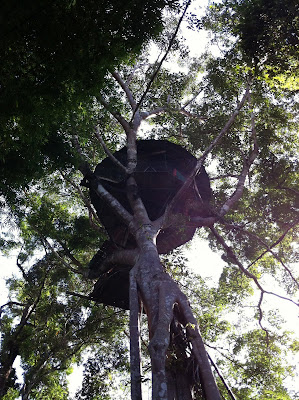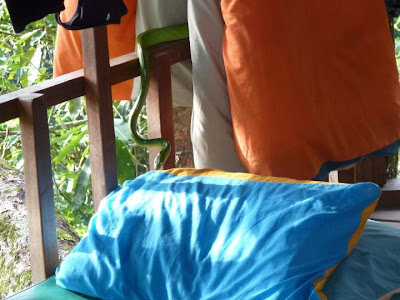This is the true story... of seven strangers... picked to live in a treehouse in the middle of the jungle... hike and zip-line together and have their lives changed... to find out what happens... when people stop being polite... and start getting real...
The Real World: Bokeo Forest
Bokeo Forest, Laos, 7/10/11 - 7/12/11
Jen J and Chris are recent college grads from Scotland. Jen is short, freckled, with reddish brown hair. She focused on law in school but has no interest in pursuing it further. Her boyfriend Chris is an engineer with a job at BP waiting for him upon his return. Tanya and Ainsley are a sweet couple from Ottawa, both schoolteachers. He's tall, scruffy, well-built and eternally friendly. She's petite, dirty blonde, and constantly falling over herself. They're visiting Jen A., another Ottawan, who lives and teaches English at an international school in Bangkok. Jen A is tall, direct, and a fast walker. She looks like a younger, more attractive Jamie Lee Curtis. Theresa is her fellow ex-pat school teacher, hailing from Maryland. Theresa is skinny with long, jet black hair. She's of Chinese descent and has recently moved to Bangkok to teach English with Jen A after a long stint in China.
Together we're embarking on the Gibbon Experience, a three-day, two-night trek through the Bokeo Forest in northern Laos. The forest's gibbon community used to be targets of poachers who would sell them for money, so much so that the population became endangered. The government intervened and created the project to help protect the gibbons and provide the ethnic tribes with an alternate source of income. The trip involves grueling hiking, exhilarating ziplining, and an overnight stay in a seven-person, three-story bamboo treehouse. But first we need to get there.
We depart Huay Xai in the pouring rain in the back of two converted Toyota trucks. Two hours later we're sopping wet but fortunately the rain has stopped as we cross from paved road into jungle path. First we wade through a murky brown river, roughly two feet in depth, water splashing up at all sides. We sit in the back of the trucks, biting our lips, hoping the cars won't sink into the river of fill with water. Luckily we're able to wade the river, but the other side doesn't look much more promising. The rain has left the dirt path in a muddy state of disrepair and each truck shakes and wobbles up the path, which is covered in dense holes almost like moon craters. In order to make it up the modest hills, the driver blasts the accelerator while thick black exhaust roars out the back. Even at full force, the Toyotas are no match for the mud and constantly get stuck or veer off the path. We stop every three minutes and get out and push the car up the hill or back onto the path. By the time we arrive at the small Hmong village at the base of the Bokeo Forest two hours later, we're covered knees down in thick mud and the white trucks are now brown.

Our guides are young Hmong tribesmen, who speak poor English. We meet them in their village of modest thatched huts, with pigs, chickens, ducks, cows, and horses roaming throughout. Upon first meeting, our new guides express their sincere interest in learning English pickup lines, which quickly becomes a trend for the next three days.



We begin our expedition with a two hour muddy hike, predominantly uphill as we sweat and pant. The hike is through dense bamboo rainforest where we encounter slugs, geckoes, and butterflies. Lunch evokes Laos' French colonial past with baguette sandwiches filled with chicken curry salad, julienned carrots, cucumber, tomatoes, chilis, and aoli.
We reach our accommodation via a short zipline. As we traverse, a large Robinson Crusoe-style treehouse quickly comes into view. Roughly diamond in shape, it has small first and third floors and a large middle floor. The bottom floor has a bathroom with a high-powered rainwater shower and squat toilet. The middle floor has sleeping room for five, with large mosquito nets, a low circular dining table, and a makeshift kitchen. Due to solar power, the treehouse is able to get minimal electricity at night, quite a feat considering its dozens of miles from power lines. The top floor is a small sunroom that sleeps two. The bamboo treehouse is roughly 300 ft in the air at the edge of a jungle clearing, overlooking three tiers of forest canopies and the mountains beyond. The house offers unparalleled 360-degree views of the entire forest.









We unpack and look over a beautiful sunset slowly coming down over the forest. One of our first sights in our new home is a giant neon green poisonous python, staring down at us from the treehouse's roof. He judges us with dark, beady black eyes, as he snacks on a large, hairy gray live mouse. Our guides try to get him away with a wooden broom and he lunges from the ceiling trying to attack. Meanwhile, we drops his live rabies-infested vermin dinner, which quickly sprints away. This only angers the python further, who continues to throw himself at our guides and making his way down from the ceiling to the floor of the house. Mr. Python takes one too many broom hits to the head and ultimately retreats outside the treehouse, likely waiting for us to fall asleep. Ah, country living.









Dinner is ziplined into our treehouse by our guides, effortlessly zipping one-handed, while the other holds large amounts of food or kettles filled with boiling water. Tonight is a feast of caramelized onion relish, sauteed oyster mushrooms, beef and chili salad, sauteed bok choy, jasmine rice, plum wine, and coffee with condensed milk. The night ends with several card games under candlelight.
I fall asleep in a thick, black mosquito net which prevents bug attacks yet also blocks any and all visibility. I am shrouded in pitch darkness which is especially scary as the forest comes alive at night. Around us, we hear forest mice sprint around our mattresses, searching for food scrapes and celebrating their exodus from the snake. Plus I'm convinced I hear that python slowly making his way back to the house. I get up to use the toilet and sprint to avoid the mice who litter the floor. In the bathroom, white moths surround my legs. Back in bed, as the mice squeaks get louder and closer, I keep praying to make it to morning without catching rabies.
***
We're up at 6am to the siren song of the Bokeo Forest gibbons, which slightly resembles high-pitched bird chirping. Although they're incredibly reclusive, and there's no guarantee to view them during the trek, we have terrific beginner's luck. We have a terrific view of the gibbon community straight from our treehouse, made even better with the addition of a telescope. We view them for two hours, spotting orange, brown, and black gibbons plus their babies, swinging from tree to tree, eating, picking lice off each other, howling, scratching, and doing pullups on the branches.
 |
| They're in there! |

Breakfast is a salty Laotian omelet, sauteed greens, fresh rambutri (a cousin of lychee) and longan fruits.
Bellies fueled for hiking, we depart on a two-hour trek through the jungle. We're dripping in sweat and breathing heavily when we arrive at the first zip line. Four taut metal lines are connected in a circle, each roughly a 1/4 mile long and anywhere from 200 - 300 ft in the air, almost adjacent with the lower-hanging clouds. Our guides seem to care more about pickup lines than safety, so we zip sans-helmet and with minimal instruction, no one offering to double check or harnesses or zip apparatuses. Instead, the guides keep turning to the women of our group, proclaiming "Hey baby, you are going my way", which is phrased as a statement instead of the traditional question. Others begin with, "hey baby, are you tired?" So we check out harnesses and knots ourselves. But no worries as extra safety instruction and jungle information would just take time away from ziplining. And we can't get enough. We fly through the highway of ziplines, smiles reaching our eyes, like kids at a McDonald's playpen.
Although sweat beads drip down our face, one jump and it clears, wind brushing in our face as we race across the forest canopy which is visible for miles. We wear padded white utility gloves which are already dark brown and torn after just 24 hours.
Despite the tall colorful athletic socks, we're nearly as popular with the mosquitoes as the leeches, which look like small black worms and cause abrupt losses of blood. The zipling is a tremendous thrill, almost like flying. It's beyond liberating and as I soar through the clouds I feel like Peter Pan. We're harnesses to the lines with one pulley, a safety carabiner, and a break fashioned out of an old bike tire. I don't press it hard enough on one run and crash land, violently twisting my arm backwards at 15mph causing a strong muscle strain for the rest of the trip.
We zip for hours, doing tricks, pretending to be Superman, contorting our bodies, racing on adjacent lines. We only break to help our guides learn more English. We finish covered in sweat, mud, zipline rust, bruises, leeches, and open sores. We look like an army medical ward. Dinner back at the treehouse is more onion relish, bok choy, beef and chili salad, plum wine, rice, plus sauteed cauliflower.
The final day means more ziplining and another multi-hour grueling uphill hike. We make a pitstop in the Hmong Village to say goodbye and thank you to our guides and meet their families.


I help one young teen decipher the lyrics to a Justin Bieber single, although I'm sure he will regret this translation in the matter of years. In between water breaks, we chase the fat black and white potbellied pigs around the village. Nearby, one older villager inexplicably kicks a beautiful stallion-esque white horse in the stomach.
 |
| Sorry, I just don't follow Justin Bieber after his revolutionary first album |
Before leaving, our whole group gets together, borrowing a guitar to sing "One" by U2, which certainly symbolizes the close-knit family our group of seven has become.
"The Magnificent Seven" as we now call ourselves.
Note: Some photos from Jen J, Jen A, and Teresa























 \
\
























No comments:
Post a Comment